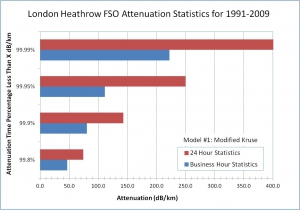
Application Areas--System Engineering and Modeling
GIS Mapping for Telecommunications, Cellular Backhaul, Cellular Coverage, Wireless Coverage, eNodeB/BTS Location Determination, Optical Fiber Network Mapping, Business Case Analyses, Population Statistics, Public Safety, and Government.
Services
• Electrical Engineering
• Link budgets (HF through optical)
• Spectral noise measurements and interference mitigation
• In-building wireless performance measurements
• Continuous Wave (CW) Testing
• Detailed propagation characteristics modeling (e.g., average expected fade durations, availability, likelihood of fades longer than X seconds, etc.)
• Atmospheric attenuation statistics modeling: microwave (MW), millimeter-wave (MMW), Free Space Optics (FSO), Molecular Absorption (using HITRAN)
• Satellite communications: RF, microwave, millimeter-wave, free space optics (inter-satellite links and satellite-ground)
• Hybrid MMW and FSO link availability/reliability calculations
• Maximum Permissible Exposure (MPE) calculations (electric field strength) for cell tower installations and in-building wireless
• HF/VHF/UHF antenna design and modeling
• Ionospheric HF propagation modeling, ionospheric HF communications modeling and reliability predictions, including latency
• Antenna tower intermodulation calculations
• LabView instrumentation control, measurements, data acquisition, and signal processing
• Link budgets (HF through optical)
• Spectral noise measurements and interference mitigation
• In-building wireless performance measurements
• Continuous Wave (CW) Testing
• Detailed propagation characteristics modeling (e.g., average expected fade durations, availability, likelihood of fades longer than X seconds, etc.)
• Atmospheric attenuation statistics modeling: microwave (MW), millimeter-wave (MMW), Free Space Optics (FSO), Molecular Absorption (using HITRAN)
• Satellite communications: RF, microwave, millimeter-wave, free space optics (inter-satellite links and satellite-ground)
• Hybrid MMW and FSO link availability/reliability calculations
• Maximum Permissible Exposure (MPE) calculations (electric field strength) for cell tower installations and in-building wireless
• HF/VHF/UHF antenna design and modeling
• Ionospheric HF propagation modeling, ionospheric HF communications modeling and reliability predictions, including latency
• Antenna tower intermodulation calculations
• LabView instrumentation control, measurements, data acquisition, and signal processing
Discussion
SpectraNet has done a wide variety of system engineering and mathematical modeling. Examples include: RF and fiber-optic link budgets; ground-to-space atmospheric attenuation as a function of optical wavelength (NASA’s “Ride the Light” project); Satellite communication links (ISL/Feeder); ionospheric propagation analysis of reliability as a function of year, season, day, and time-of-day as a function of HF frequency; statistical details of microwave or millimeter-wave fade durations that are not covered by typical commercial propagation programs; free space optics (FSO) link budgets that include predicted availabilities for any given city based on visibility statistics; calculations of ice attenuation on microwave antenna radomes; return on investment models for broadband wireless deployments with variable capex, opex, and monthly subscriber fees, etc.
In short, if you have an unusual problem that needs to be better understood through careful modeling, just ask. We use MathCad, Octave (similar to Matlab), LabView, and can create custom programs with easy to use interfaces using Excel VBA.
We also have a small lab with various electronic equipment such as a 1 Gsps digital sampling oscilloscope, a 50 MHz arbitrary function generator, frequency counters, radios, and a large assortment of RF hardware. We have built custom electronic boards for one of Boeing’s R&D groups, and can design/model circuitry using SPICE based software.
